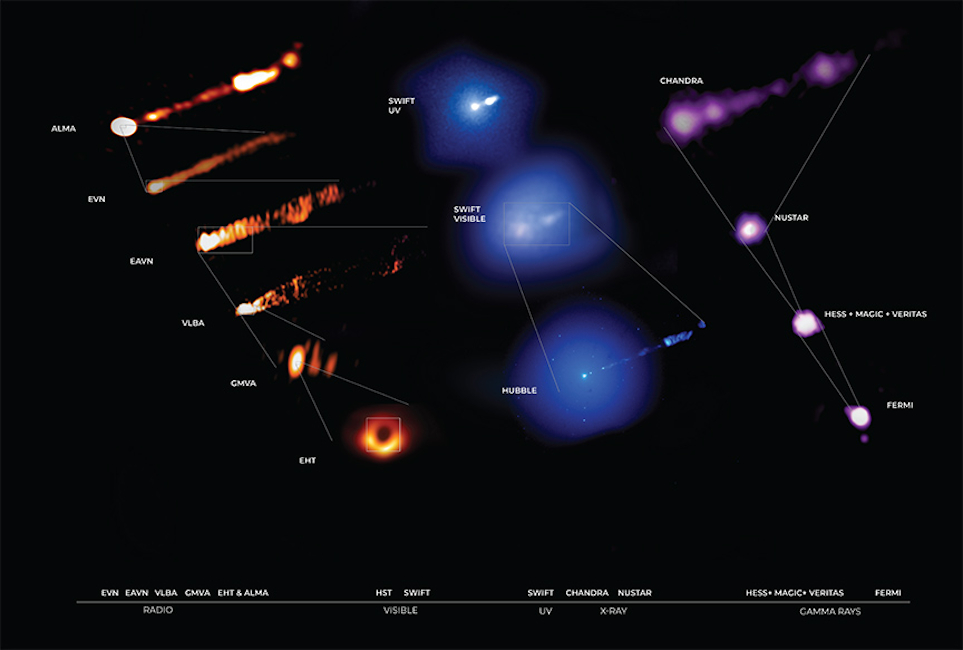
 Credit: The EHT Multi-wavelength Science Working Group; the EHT Collaboration; ALMA (ESO/NAOJ/NRAO); the EVN; the EAVN Collaboration; VLBA (NRAO); the GMVA; the Hubble Space Telescope; the Neil Gehrels Swift Observatory; the Chandra X-ray Observatory; the Nuclear Spectroscopic Telescope Array; the Fermi-LAT Collaboration; the H.E.S.S collaboration; the MAGIC collaboration; the VERITAS collaboration; NASA and ESA.
Credit: The EHT Multi-wavelength Science Working Group; the EHT Collaboration; ALMA (ESO/NAOJ/NRAO); the EVN; the EAVN Collaboration; VLBA (NRAO); the GMVA; the Hubble Space Telescope; the Neil Gehrels Swift Observatory; the Chandra X-ray Observatory; the Nuclear Spectroscopic Telescope Array; the Fermi-LAT Collaboration; the H.E.S.S collaboration; the MAGIC collaboration; the VERITAS collaboration; NASA and ESA.
Scaling M87
Black holes, astrophysically speaking, are tiny objects. Typical black holes in the Milky Way are only a few kilometers in "size" (and so would fit easily - if uncomfortably- within the confines of most cities on earth), and even the largest (i.e. the most massive) black holes found at the centers of galaxies are barely larger than our own solar system. Despite their tiny size, they pack a powerful punch; most, if not all, active black holes drive particle jets near the speed of light which stretch far out into intergalactic space, millions of times the size of the black hole that generates them. The outpouring of energy and matter in these jets play a crucial role in the cosmic ecosystem, driving feedback of enriched material from the galaxy into intergalactic space, reshaping the intergalactic material from which new galaxies can form. How exactly this happens is not well understood. The active galaxy M87 provides astrophysicists with a unique opportunity to study the details of the way black holes drive jets. At its center, M87 has a 6.5 billion solar mass black hole, currently the only black hole to be directly imaged and to have its magnetic field measured. This supermassive black hole also drives a particle jet, and now the size, shape, and energetics of this jet have been measured in detail, using a superpowerful array of spaced-based and ground-based instruments covering nearly the entire electromagnetic spectrum. The montage shown above is a compilation of these images, covering size scales of about 60 light-hours to about 300,000 lightyears, a factor of nearly 50 million in distance scale. These observations help scientists understand how energy propagates alone the jet, and helps us understand how such jets can remain so narrow over such large distances.
Published: April 19, 2021
<
HEA Dictionary ● Archive
● Search HEAPOW
● Other Languages
● HEAPOW on Facebook
● Download all Images
● Education ● HEAD
>

Each week the HEASARC
brings you new, exciting and beautiful images from X-ray and Gamma ray
astronomy. Check back each week and be sure to check out the HEAPOW archive!
Page Author: Dr. Michael F. Corcoran
Last modified Monday, 26-Feb-2024 17:10:43 EST


